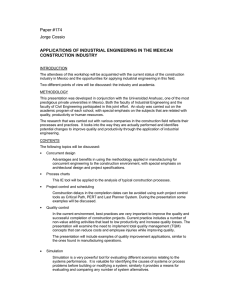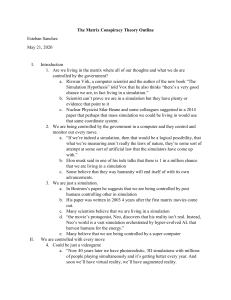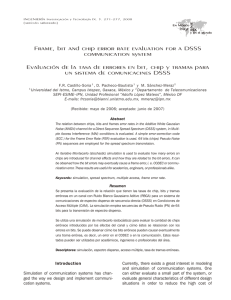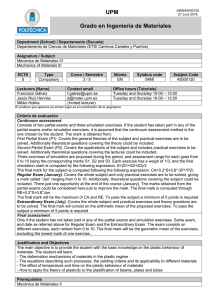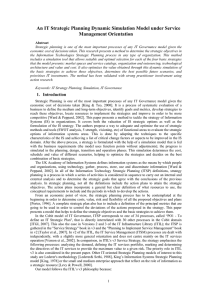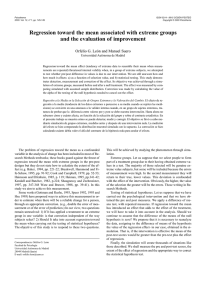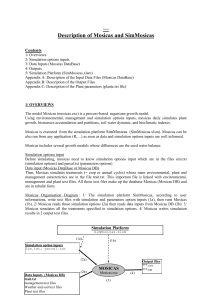Pre-simulation preparation and briefing practices for healthcare
Anuncio
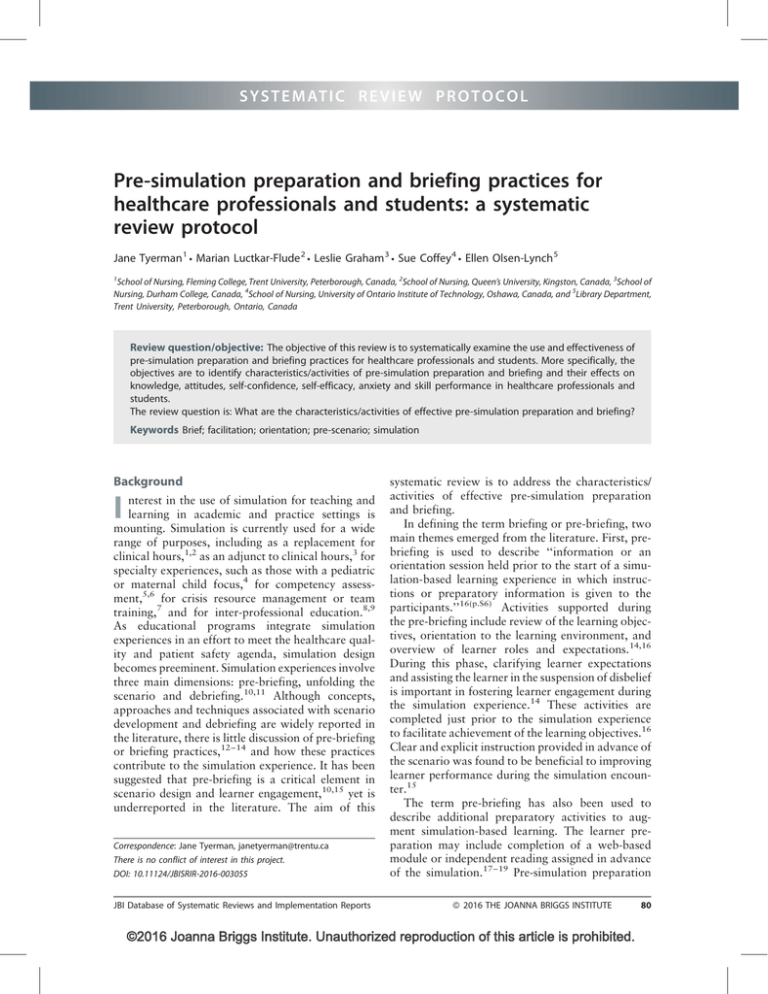
S YS T E M AT I C R E V I E W P R O T O C O L Pre-simulation preparation and briefing practices for healthcare professionals and students: a systematic review protocol Jane Tyerman 1 Marian Luctkar-Flude 2 Leslie Graham 3 Sue Coffey 4 Ellen Olsen-Lynch 5 1 School of Nursing, Fleming College, Trent University, Peterborough, Canada, 2School of Nursing, Queen’s University, Kingston, Canada, 3School of Nursing, Durham College, Canada, 4School of Nursing, University of Ontario Institute of Technology, Oshawa, Canada, and 5Library Department, Trent University, Peterborough, Ontario, Canada Review question/objective: The objective of this review is to systematically examine the use and effectiveness of pre-simulation preparation and briefing practices for healthcare professionals and students. More specifically, the objectives are to identify characteristics/activities of pre-simulation preparation and briefing and their effects on knowledge, attitudes, self-confidence, self-efficacy, anxiety and skill performance in healthcare professionals and students. The review question is: What are the characteristics/activities of effective pre-simulation preparation and briefing? Keywords Brief; facilitation; orientation; pre-scenario; simulation Background nterest in the use of simulation for teaching and learning in academic and practice settings is mounting. Simulation is currently used for a wide range of purposes, including as a replacement for clinical hours,1,2 as an adjunct to clinical hours,3 for specialty experiences, such as those with a pediatric or maternal child focus,4 for competency assessment,5,6 for crisis resource management or team training,7 and for inter-professional education.8,9 As educational programs integrate simulation experiences in an effort to meet the healthcare quality and patient safety agenda, simulation design becomes preeminent. Simulation experiences involve three main dimensions: pre-briefing, unfolding the scenario and debriefing.10,11 Although concepts, approaches and techniques associated with scenario development and debriefing are widely reported in the literature, there is little discussion of pre-briefing or briefing practices,12–14 and how these practices contribute to the simulation experience. It has been suggested that pre-briefing is a critical element in scenario design and learner engagement,10,15 yet is underreported in the literature. The aim of this I Correspondence: Jane Tyerman, [email protected] There is no conflict of interest in this project. DOI: 10.11124/JBISRIR-2016-003055 JBI Database of Systematic Reviews and Implementation Reports systematic review is to address the characteristics/ activities of effective pre-simulation preparation and briefing. In defining the term briefing or pre-briefing, two main themes emerged from the literature. First, prebriefing is used to describe ‘‘information or an orientation session held prior to the start of a simulation-based learning experience in which instructions or preparatory information is given to the participants.’’16(p.S6) Activities supported during the pre-briefing include review of the learning objectives, orientation to the learning environment, and overview of learner roles and expectations.14,16 During this phase, clarifying learner expectations and assisting the learner in the suspension of disbelief is important in fostering learner engagement during the simulation experience.14 These activities are completed just prior to the simulation experience to facilitate achievement of the learning objectives.16 Clear and explicit instruction provided in advance of the scenario was found to be beneficial to improving learner performance during the simulation encounter.15 The term pre-briefing has also been used to describe additional preparatory activities to augment simulation-based learning. The learner preparation may include completion of a web-based module or independent reading assigned in advance of the simulation.17–19 Pre-simulation preparation ß 2016 THE JOANNA BRIGGS INSTITUTE ©2016 Joanna Briggs Institute. Unauthorized reproduction of this article is prohibited. 80 SYSTEMATIC REVIEW PROTOCOL may also include a list of essential skills that are to be mastered by the learner prior to attending the simulation experience.19 Other strategies for pre-scenario preparatory work include creating cognitive aids such as cue cards or concept maps to be used during the simulation scenario as a quick reference.19 Prescenario preparation can be guided by learning outcomes and descriptors provided by assessment rubrics, which may help learners to close the gap between their actual and desired performance.20 Attendance at additional laboratory practice sessions designed to refine psychomotor skills could also be included in pre-simulation preparation.13 Discussion continues when determining the correct dose and types of pre-simulation activity.17 Gantt13 suggests that simulation-based learning experiences are associated with a physiologic stress response, yet too much stress can inhibit the learning process leaving the learner unable to perform during the simulation. When learners experience a level of comfort in the environment as a result of orientation and prior exposure to the simulation scenario, the anxiety associated with the simulation experience has been shown to be lessened. Decreasing anxiety promotes student engagement during simulation experiences, which in turn supports critical thinking and reflective practice.13–18 The degree to which learners should optimally be provided with cues during the simulation remains in question. Sharoff18 provided the learners with comprehensive preparatory materials, which could be viewed as providing a high level of cueing. Depending on the formative or summative nature of the assessment, it may or may not be appropriate to cue the learner. Gantt13 notes a lack of evidence to recommend the actual components of preparation for simulation-based learning. Although lectures, readings, videos and web-based materials are common methods of preparing learners, there is a lack of evidence to favor one method over another. Additionally, evidence points to variations in the amount of assigned pre-simulation preparation that is actually completed by learners prior to attending the simulation experience.17 Further, while learners may be assigned preparatory materials, there is no verification of review and understanding of this information.17 For the purpose of this review, we maintain that simulation experiences involve three learning stages: preparation, participation and debriefing,10 and that JBI Database of Systematic Reviews and Implementation Reports J. Tyerman et al. the preparation stage includes the pre-briefing or briefing, which occurs immediately prior to participation in the scenario. To guide this review, it is necessary to define the key terms: Pre-simulation preparation is the content or material provided at unspecified times in advance of the simulation experience. Broadly, this includes course-related content in any format shared with the learner in advance of the scenario, to optimize the learning. Traditionally, lecture or other preparatory work such as assigned readings are considered presimulation activities. Additionally, methods of selfassessment such as pre-simulation quizzes, selfreflections, assessment rubrics or other evaluations completed by the learner to identify knowledge or skill gaps in advance of the simulation experience may be considered pre-simulation preparation activities. Pre-briefing and briefing are used synonymously to indicate the interaction between the facilitator and the learner, just prior to the simulation experience. During this interaction, the learner is prepared to fully engage in the learning environment. Considered a more active experience, the facilitator may review the learning objectives, provide equipment orientation and share other pertinent information relevant to the specific simulation experience. As the science of simulation continues to evolve, emphasis previously placed largely on scenario development and debriefing must now expand to other components of the learning experience. As the focus shifts to other key elements of simulation design, greater interest is directed toward pre-simulation preparation and pre-briefing practices and how these contribute to the simulation experience and learning. Yet few literature reviews have been completed on this topic. A search of the JBI Database of Systematic Reviews and Implementation Reports, Cochrane Database of Systematic Reviews, Medline, the Cumulative Index to Nursing and Allied Health Literature (CINAHL) and Epistemonikos found no existing systematic reviews completed or proposed on pre-simulation preparation. However, PageCutrara completed a comprehensive review in 2014 specifically on pre-briefing of nursing literature only.11 The review included 15 articles, and reported that the role of pre-briefing may be beneficial in developing critical thinking and clinical judgment.11 Chamberlain12 performed a concept analysis in 2015 ß 2016 THE JOANNA BRIGGS INSTITUTE ©2016 Joanna Briggs Institute. Unauthorized reproduction of this article is prohibited. 81 SYSTEMATIC REVIEW PROTOCOL of pre-briefing in nursing simulation in which she reported the results of a review conducted using a single database, CINAHL. After review of 23 articles, it was recommended that pre-briefing be conducted by faculty educated in the use of simulation to enhance learner engagement and effectiveness of the simulation experience.12 To expand on the existing work on this topic, our review will examine all pre-simulation preparation activities, including pre-briefing in all health professionals and health professional students. For this review, outcome measures for quality simulation experiences include knowledge, attitudes skill performance, self-efficacy and self-confidence. A variety of tools exist such as the Simulation Evaluation Tool, which has been used to examine student satisfaction and self-confidence while engaging in simulation.21,22 In many studies, student satisfaction and self-confidence were measured, revealing most students enjoyed the active learning that occurs in simulation.22–26 Confidence, most often assessed as single-item measure on a questionnaire, increased after most simulated learning experiences.27,28 Increased self-confidence can lead to enhanced performance and competency, which results in an increased self-efficacy enhancing performance through affective, cognitive and motivational processes.25,29,30 For the purposes of this appraisal, any activity that is completed in preparation of a simulation experience will be included for review. Concepts related to pre-simulation preparation and pre-briefing practices will be explored within the context of healthcare professional’s education. As more emphasis is placed on simulation-based learning experiences for healthcare students and professionals, a closer examination of the role of pre-simulation preparation and pre-briefing practices is warranted, specifically including a focus on how they contribute to the learning process. Inclusion criteria Types of participants This quantitative review will consider studies from any setting that include any health professionals and/or health professional students participating in simulation. Simulation may include medium fidelity, hybrid simulations or high-fidelity simulations using computerized manikins or standardized patients. JBI Database of Systematic Reviews and Implementation Reports J. Tyerman et al. Types of intervention(s)/phenomena of interest The review will consider studies that evaluate characteristics/activities of pre-simulation preparation and/or pre-simulation briefing (or prebriefing). Comparators may include traditional lecture preparation, alternate preparation or briefing, or no preparation and/or briefing activities. Outcomes This review will consider studies that include any of the following learner outcome measures: knowledge, attitudes, self-confidence, self-efficacy, anxiety and skill performance. A variety of measures are implemented to evaluate simulation-based learning activities. Competency-based checklists, rubrics and scales are used in the evaluation of simulation-based learning outcome measures. Instruments used in the studies for this review range from researcher developed tools to well-validated and reliable instruments. Types of studies This review will consider both experimental and epidemiological study designs, including randomized controlled trials, non-randomized controlled trials, quasi-experimental, before and after studies, prospective and retrospective cohort studies, casecontrol studies and analytical cross-sectional studies. The review will also consider descriptive epidemiological study designs, including case series, individual case reports and descriptive cross-sectional studies. Search strategy The search strategy aims to find both published and unpublished studies. A three-step search strategy will be utilized in this review. An initial limited search of MEDLINE and CINAHL will be undertaken followed by analysis of the text words contained in the title and abstract and the index terms used to describe the article. A second search using all identified keywords and index terms will then be undertaken across all included databases. Third, the reference list of all identified reports and articles will be searched for additional studies. No language limitation will be placed on the search strategy. Research studies published in languages other than English will be tallied and reported. To be thorough, no date limit will be placed on the search strategy. ß 2016 THE JOANNA BRIGGS INSTITUTE ©2016 Joanna Briggs Institute. Unauthorized reproduction of this article is prohibited. 82 SYSTEMATIC REVIEW PROTOCOL The databases to be searched include: Medline, CINAHL, PsycINFO, ERIC, Web of Science, and Cochrane Central Register of Controlled Trials. The search for unpublished studies will include: Dissertation Abstracts, Google, and selected grey literature databases/gateways (e.g. OpenGrey, Grey Literature Report, Grey Source). Initial keywords to be used will be: simulation, prebrief$, brief$, prescenario, pre-scenario, presimulation, presimulation, pretrain$, pre-train$, preparation, orientation, facilitation Assessment of methodological quality Quantitative articles selected for retrieval will be assessed by two independent reviewers for methodological validity prior to inclusion in the review using standardized critical appraisal instruments from the Joanna Briggs Institute Meta-Analysis of Statistics Assessment and Review Instrument (JBI-MAStARI) (Appendix I). Any disagreements that arise between the reviewers will be resolved through discussion or with a third reviewer. Data extraction Quantitative data will be extracted from articles included in the review independently by two reviewers, using the standardized data extraction tool from JBI-MAStARI (Appendix II). The data extracted will include specific details about the interventions (e.g. duration, content and method of delivery), populations, study methods and outcomes of significance to the review question and specific objectives. For missing information or to clarify unclear data, the authors of primary studies will be contacted. Any disagreements that arise between the reviewers will be resolved through discussion or with a third reviewer. Data synthesis Quantitative articles will, wherever possible, be pooled in statistical meta-analysis using JBI-MAStARI. All results will be subject to double data entry. Effect sizes expressed as odds ratio (for categorical data) and weighted mean differences (for continuous data) and their 95% confidence intervals will be calculated for analysis. Heterogeneity will be assessed statistically using the standard x2 and also explored using subgroup analyses based on the different quantitative study designs included in this JBI Database of Systematic Reviews and Implementation Reports J. Tyerman et al. review. Where statistical pooling is not possible the findings will be presented in narrative form, including tables and figures to aid in data presentation, wherever appropriate. The MAStARI critical appraisal tool will be used to evaluate the studies, blinded to each reviewer. References 1. Arthur C, Kable A, Levett-Jones T. Human patient simulation manikins and information communication technology use in Australian schools of nursing: a cross-sectional survey. Clin Simul Nurs 2011;7(6):e219–27. 2. Hayden J, Smiley R, Alexander M, Kardong-Edgren S, Jeffries P. The NCSBN National Simulation Study: a longitudinal, randomized, controlled study replacing clinical hours with simulation in prelicensure nursing education. J Nurs Regul 2014;5(2 Suppl):S3–40. 3. Wolfgram LJ, Quinn AO. Integrating simulation innovatively: evidence in teaching in nursing education. Clin Simul Nurs 2012;8(5):e169–75. 4. Cato ML, Lasater K, Peeples AI. Nursing students’ self-assessment of their simulation experiences. Nurs Educ Perspect 2009;30(2):105–8. 5. Benner PE. Educating nurses: a call for radical transformation. 1st ed San Francisco, CA: Jossey-Bass; 2010. 6. Seropian MA. General concepts in full scale simulation: getting started. Anesth Analg 2003;97(6):1695–705. 7. Anderson M, LeFlore JL, Anderson JM. Evaluating videotaped role-modeling to teach crisis resource management principles. Clin Simul Nurs 2013;9(9):e343–54. 8. Alinier G, Harwood C, Harwood P, Montague S, Huish E, Ruparelia K, et al. Immersive clinical simulation in undergraduate health care interprofessional education: knowledge and perceptions. Clin Simul Nurs 2014;10(4):e205– 16. 9. Palaganas J. Using health care simulation for interprofessional education and practice. In: Ulrich BT, Mancini ME, editors. Mastering simulation: a handbook for success. Indianapolis, IN: Sigma Theta Tau International, 2014;175–201. 10. Husebø SE, Friberg F, Søreide E, Rystedt H. Instructional problems in briefings: How to prepare nursing students for simulation-based cardiopulmonary resuscitation training. Clin Simul Nurs 2012;8(7):e307–18. 11. Page-Cutrara K. Use of Prebriefing in nursing simulation: a literature review. J Nurs Educ 2014;53(3):136–41. 12. Chamberlain J. Prebriefing in nursing simulation: a concept analysis using Rodger’s methodology. Clin Simul Nurs 2015;11(7):318–22. 13. Gantt LT. The effect of preparation on anxiety and performance in summative simulations. Clin Simul Nurs 2013;9(1): e25–33. 14. Rudolph JW, Raemer DB, Simon R. Establishing a safe container for learning in simulation: the role of the presimulation briefing. Simul Healthc 2014;9(6):339–49. ß 2016 THE JOANNA BRIGGS INSTITUTE ©2016 Joanna Briggs Institute. Unauthorized reproduction of this article is prohibited. 83 SYSTEMATIC REVIEW PROTOCOL 15. Brackney DE, Priode KS. Creating context with prebriefing: a case example using simulation. J Nurs Educ Pract 2014;5(1):129. 16. Meakim C, Boese T, Decker S, Franklin A, Gloe D, Lioce L, et al. Standards of best practice: simulation. Standard I: terminology. Clin Simul Nurs 2011;7(4 Suppl):S3–7. 17. Franklin AE, Sideras S, Gubrud-Howe P, Lee CS. Comparison of expert modeling versus voice-over PowerPoint lecture and presimulation readings on novice nurses’ competence of providing care to multiple patients. J Nurs Educ 2014;53(11):615–22. 18. Waxman KT. The development of evidence-based clinical simulation scenarios: guidelines for nurse educators. J Nurs Educ 2010;49(1):29–35. 19. Sharoff L. Simulation: pre-briefing preparation, clinical judgment and reflection. What is the connection? J Contemp Med 2015;5(2):88–101. 20. Ellery K. Assessment for learning: a case study using feedback effectively in an essay-style test. Assess Eval High Educ 2008;33(4):421–9. 21. Howard V, Englert N, Kameg K, Perrozzi K. Integration of simulation across the curriculum: Student and faculty perspectives. Clin Simul Nurs 2011;7(1):e1–10. 22. Howard V, Ross C, Mitchell A, Nelson G. Human patient simulators and interactive case studies: a comparative analysis of learning outcomes and student perceptions. CIN:Comput Inform Nu 2010;28(1):42–8. JBI Database of Systematic Reviews and Implementation Reports J. Tyerman et al. 23. Bambini D, Washburn J, Perkins R. Outcomes of clinical simulation for novice nursing students: communication, confidence, clinical judgment. Nurs Educ Perspect 2009;30(2):79–82. 24. O’Donnell J, Decker S, Howard V, Levett-Jones T, Miller C. NLN/Jeffries. Simulation Framework state of the science project: Simulation learning outcomes. Clin Simul Nurs 2014;10:373–82. 25. Smith S, Roehrs C. High fidelity simulation: Factors correlated with nursing student satisfaction and self-confidence. Nurs Educ Perspect 2009;30(2):74–8. 26. Zulkosky K. (2012). Simulation use in the classroom: Impact on knowledge acquisition, satisfaction, and self-confidence. Clin Simul Nurs 2012;8(1):25–33. 27. McCaughey C, Traynor M. The role of simulation in nurse education. Nurse Educ Today 2010;30(8):827–32. 28. Mould J, White H, Gallagher R. Evaluation of a critical simulation series for undergraduate nursing students. Contemp Nurse 2011;38(1-2):180–90. 29. Arnold J, Johnson L, Tucker S, Malec J, Henrickson S, Dunn W. Evaluation tools in simulation learning: performance and self-efficacy in emergency response. Clin Simul Nurs 2009;5(1):e35–43. 30. Bandura A. (1989). Regulation of cognitive process through perceived self-efficacy. Dev Psychol 1898;25(5):729–35. ß 2016 THE JOANNA BRIGGS INSTITUTE ©2016 Joanna Briggs Institute. Unauthorized reproduction of this article is prohibited. 84 SYSTEMATIC REVIEW PROTOCOL J. Tyerman et al. Appendix I: MAStARI appraisal instruments JBI Critical Appraisal Checklist for Experimental Studies Reviewer _________________________________ Date __________________ Author _______________________________________________Year ______ Yes 1. Was the assignment to treatment groups truly random? 2. Were participants blinded to treatment allocation? 3. Was allocation to treatment groups concealed from the allocator? No Unclear 4. Were the outcomes of people who withdrew described and included in the analysis? 5. Were those assessing the outcomes blind to the treatment allocation? 6. Were control and treatment groups comparable at entry? 7. Were groups treated identically other than for the named interventions? 8. Were outcomes measured in the same way for all groups? 9. Were outcomes measured in a reliable way? 10. Was appropriate statistical analysis used? Overall appraisal: Include Exclude Seek further info Comments (including reasons for exclusion): JBI Database of Systematic Reviews and Implementation Reports ß 2016 THE JOANNA BRIGGS INSTITUTE ©2016 Joanna Briggs Institute. Unauthorized reproduction of this article is prohibited. 85 SYSTEMATIC REVIEW PROTOCOL J. Tyerman et al. JBI Critical Appraisal Checklist for Comparable Cohort/ Case Control Reviewer _________________________________ Date __________________ Author _______________________________________________Year ______ Yes 1. Is sample representative of patients in the population as a whole? 2. Are the patients at a similar point in the course of their condition/illness? 3. Has bias been minimized in relation to selection of cases and of controls? 4. No Unclear Are confounding factors identified and strategies to deal with them stated? 5. Are outcomes assessed using objective criteria? 6. Was follow up carried out over a sufficient time period? 7. Were the outcomes of people who withdrew described and included in the analysis? 8. Were outcomes measured in a reliable way? 9. Was appropriate statistical analysis used? Overall appraisal: Include Exclude Seek further info Comments (including reasons for exclusion): JBI Database of Systematic Reviews and Implementation Reports ß 2016 THE JOANNA BRIGGS INSTITUTE ©2016 Joanna Briggs Institute. Unauthorized reproduction of this article is prohibited. 86 SYSTEMATIC REVIEW PROTOCOL J. Tyerman et al. JBI Critical Appraisal Checklist for Descriptive/ Case Series Reviewer _________________________________ Date __________________ Author _______________________________________________Year ______ Yes 1. Was study based on a random or pseudo- random sample? 2. Were the criteria for inclusion in the sample clearly defined? 3. Were confounding factors identified and strategies to deal with them stated? 4. Were outcomes assessed using objective criteria? No Unclear 5. If comparisons are being made, was there sufficient description of the groups? 6. Was follow up carried out over a sufficient time period? 7. Were the outcomes of people who withdrew described and included in the analysis? 8. Were outcomes measured in a reliable way? 9. Was appropriate statistical analysis used? Overall appraisal: Include Exclude Seek further info Comments (including reasons for exclusion): JBI Database of Systematic Reviews and Implementation Reports ß 2016 THE JOANNA BRIGGS INSTITUTE ©2016 Joanna Briggs Institute. Unauthorized reproduction of this article is prohibited. 87 SYSTEMATIC REVIEW PROTOCOL J. Tyerman et al. Appendix II: Data extraction instruments MAStARI data extraction instrument JBI Data Extraction Form for Experimental/Observational Studies Reviewer Date Author Year Journal Record Number Study Method Participants RCT Quasi-RCT Retrospective Observational Longitudinal Other Setting Population Sample size Intervention 1 Intervention 2 Intervention 3 Interventions Intervention 1 Intervention 2 Intervention 3 Clinical outcome measures Outcome Description JBI Database of Systematic Reviews and Implementation Reports Scale/measure ß 2016 THE JOANNA BRIGGS INSTITUTE ©2016 Joanna Briggs Institute. Unauthorized reproduction of this article is prohibited. 88 SYSTEMATIC REVIEW PROTOCOL J. Tyerman et al. Study results Dichotomous data Outcome Intervention ( ) Intervention ( ) number / total number / total number number Continuous data Outcome Intervention ( ) Intervention ( mean & SD mean & SD (number) (number) ) Authors’ Conclusions Comments JBI Database of Systematic Reviews and Implementation Reports ß 2016 THE JOANNA BRIGGS INSTITUTE ©2016 Joanna Briggs Institute. Unauthorized reproduction of this article is prohibited. 89
